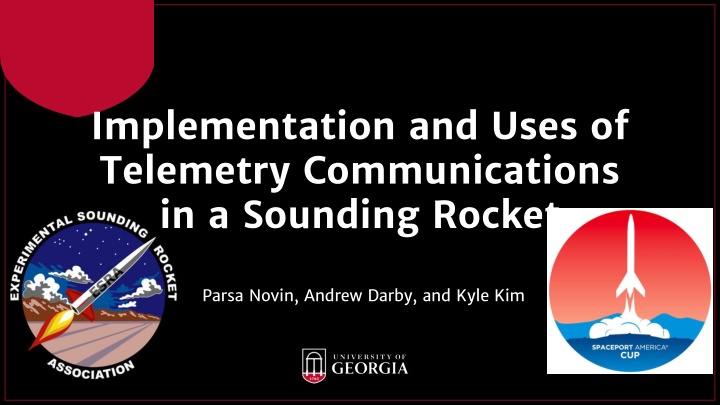
Telemetry Communications & Hardware Integration for Sounding Rocket
Explore the implementation of telemetry communications in a sounding rocket, including power management, interfacing communication modules, overall design and integration, camera systems, IMU code implementation, RRC3 data handling, and LoRa communication protocols.
Download Presentation

Please find below an Image/Link to download the presentation.
The content on the website is provided AS IS for your information and personal use only. It may not be sold, licensed, or shared on other websites without obtaining consent from the author. If you encounter any issues during the download, it is possible that the publisher has removed the file from their server.
You are allowed to download the files provided on this website for personal or commercial use, subject to the condition that they are used lawfully. All files are the property of their respective owners.
The content on the website is provided AS IS for your information and personal use only. It may not be sold, licensed, or shared on other websites without obtaining consent from the author.
E N D
Presentation Transcript
Implementation and Uses of Telemetry Communications in a Sounding Rocket Parsa Novin, Andrew Darby, and Kyle Kim
Power Management Central USB-C Port Provides both power delivery and serial communication. Battery Management System (BMS) Supports 2S3P lithium-ion charging via high-power USB-C. Voltage Regulation 5V LDOs for peripherals; 3.3V and 1.8V LDOs for logic circuits. 2
Interfacing Communication Module Enables serial interface with the Raspberry Pi. Bidirectional radio that allows for us to send directions and commands to the Pi. This setup also allows for on-field troubleshooting through use of the usb-c port. 3
Overall Design and Integration - Small form fit into 5.5 ID rocket body tube - Compact custom hardware for specific telemetry requirements - Raspberry Pi CM4 acting as OBC and peripheral management - 2s3p Lithium-Ion battery back to power system 4
Camera Camera utilizes an NTSC Analog Signal. The process for actualizing the data involves to use of an serializer, where data is collected through the use of an ADC, which outputs 8 bits of parallel data on a cycle. Deserialization of that data comes about due to the FPDII protocol, where data is then turned into differential pairs. IMG_0946.MOV 5
IMU Code Implementation The IMU utilizes a very basic implementation of Arduino code, which we connect using an I2C connection. The Code snippet below ultimately generates yaw, pitch, and roll. Also utilizes the use of serial prints to reduce possible weak points in code. 6
RRC3 Code Implementation RRC3 sends data in the form of packets structured as XX:XX (Time Stamp), XX (Temperature), XX(Velocity) to a memory buffer. Our program reads any and all data coming into the buffer in order to further process it for data collection. Multiple small oddities scattered within the code to account for certain details, such as carriage returns. Someone ask me about the yapcap 7
LoRa Communication Theoretical Airframe length is 255 Bytes, however due to memory safety issues we have decided to only utilize 250 Byte. Transmission happens at 30 dB at 1W of transmission power. 8
Ground Station The Ground Station neatly formats all the data we collect from all sensors/data- collectors. The backend utilizes multiple python scripts to write pertinent data into multiple CSV file. Visualization of this data was possible through matplotlib library. 9
Data Logging Data logging happens both on the Ground Station and and the OBC. Data logging twice ensures that errors in data remain minimal, along with providing two repositories of information to pull from. We collect multiple types of data which includes: Attitude, Altitude, Temperature, Velocity, Servo Actuation, and many more. 10
